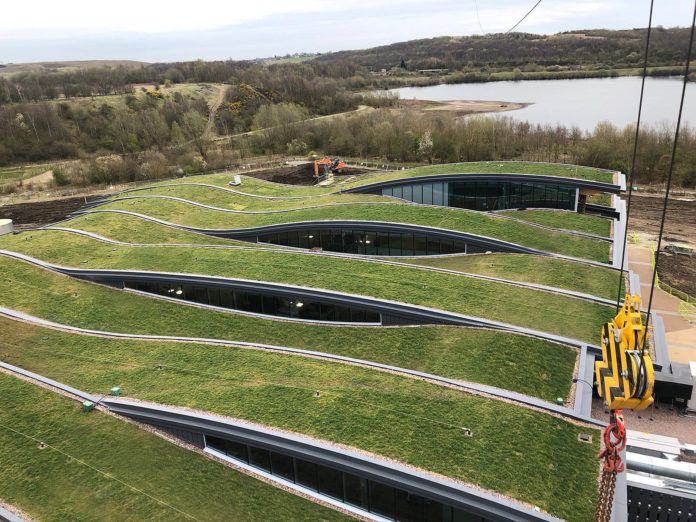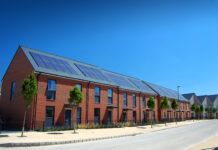
Here, read about how Geogreen Solutions has installed a green roof on Leeds Skelton Motorway Services and the benefits it brings including aesthetics, improving biodiversity, natural soundproofing, and sustainable insulation.
Blending into the surrounding lakeside, the main 5,277m2 amenity building of the new Leeds Skelton Lake Motorway services, featuring an over-arching, undulating green roof configured in eleven separate sections in a unique ‘ribbon’ pattern has been recognised with a prestigious British Association of Landscape Industries (BALI) award. The wildflower roof system was delivered by green roof designers ABG Geosynthetics and their BALI affiliated installation partners Geogreen Solutions.
Geogreen’s work encompassed all aspects of the installation for the 11 separate ribbon areas and the judges recognised the contribution the roof design makes to enhancing the biodiversity of the site, providing a significant area of native grassland for local insect and bird species.
The green roof also plays an important function as part of the development’s overall sustainable drainage strategy by absorbing rainwater and minimising surface water run-off, with as much as 95% of rainfall naturally absorbed into the vegetated surface. The vegetation, growing media and filtration fabrics within the green roof construction also helps filter dust and pollution from the air and rainfall, thus reducing the amount of chemicals and pollutants that reach the surrounding river networks.
Incorporating a green roof also significantly reduces the carbon emissions from the amenity building, by allowing the heat generated to be drawn into the cool roof construction and then dissipated more readily to the environment than with traditional roof constructions. In summer, this reduces the air conditioning requirement whilst providing a level of insulation against heat loss in winter. The green roof is also very good at reducing low frequency sounds from the nearby motorway, with the extensive build up insulating up to 40dB.
The green roof build-up
The underlying structure for the extensive wildflower meadow roof is constructed from a series of interconnected glulam beams, manufactured by fixing timber boards together and forming them into the curved sections. The beams are then spanned using structural deck cassette panels of 20mm thick in three layers.
A Kemperol cold applied liquid membrane is applied to the timber panels to give a fully adhered, monolithic waterproofing to encapsulate the surface and preserve the deck from weathering. A 180 mm thick XPS insulation board plus a water control layer, is installed directly onto the waterproofing to complete the inverted warm roof build up.
For the base of the living roof structure, a combination of 20mm and 40mm deep Roofdrain geocomposite reservoir boards were used. The main core of the reservoir board features a grid of storage cups to attenuate rainwater and provide irrigation for planting during dry spells. Small holes in-between the cuspates allow excess rainwater to channel to the nearest drainage outlets, preventing the root growing media from becoming waterlogged and stopping water pressure build-up on the water control layer.
During the next phase of the green roof construction, a biodiverse growing media mix was deposited onto the geocomposite layer and levelled to a depth of 100mm. The material is lightweight to minimise loading on the roof structure and contains organic content to retain moisture and nutrients for growing the wildflower and sedum plants.
To complete the living roof installation, a total of 4,622m2 of meadow planting was provided by Wildflower Turf, in a ratio of 20% grass and 80% flowers, with a mixture of 34 different species. The roof turf was grown at a local nursery especially for the project and designed to thrive in the exposed conditions and was supplemented with 14,200m2 of Wildflower seed to boost the density of the meadow and encourage it to spread over the wider landscape.
The green roof is subject to an annual maintenance cut in August/September time, once flowering plants have set seed and arisings are removed from the roof to avoid nutrient build-up. Cutting the plants back to 1 to 2 inches in length ensures that re-growth and species diversity continues year-on-year.



